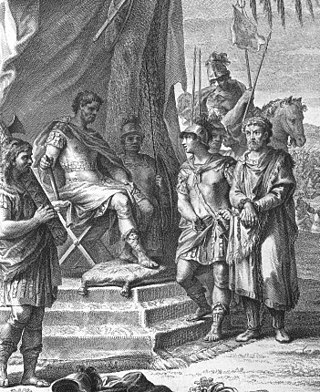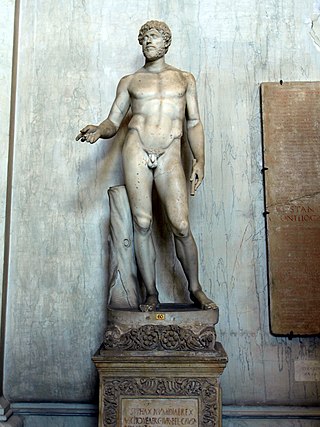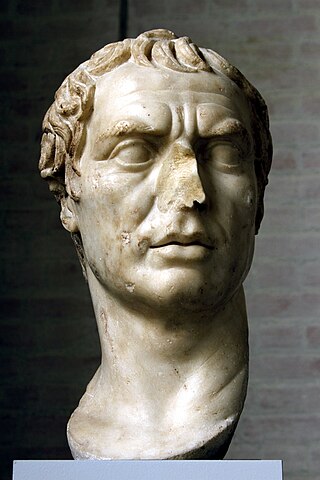
This article concerns the 200 BC decade, that lasted from 209 BC to 200 BC.
Year 203 BC was a year of the pre-Julian Roman calendar. At the time it was known as the Year of the Consulship of Caepio and Geminus. The denomination 203 BC for this year has been used since the early medieval period, when the Anno Domini calendar era became the prevalent method in Europe for naming years.

Numidia was the ancient kingdom of the Numidians in northwest Africa, initially comprising the territory that now makes up Algeria, but later expanding across what is today known as Tunisia and Libya. The polity was originally divided between the Massylii in the east and the Masaesyli in the west. During the Second Punic War, Masinissa, king of the Massylii, defeated Syphax of the Masaesyli to unify Numidia into the first Berber state in present-day Algeria. The kingdom began as a sovereign state and later alternated between being a Roman province and a Roman client state.

Jugurtha or Jugurthen was a king of Numidia. When the Numidian king Micipsa, who had adopted Jugurtha, died in 118 BC, Jugurtha and his two adoptive brothers, Hiempsal and Adherbal, succeeded him. Jugurtha arranged to have Hiempsal killed and, after a civil war, defeated and killed Adherbal in 112 BC.
The Battle of Zama was fought in 202 BC in what is now Tunisia between a Roman army commanded by Scipio Africanus and a Carthaginian army commanded by Hannibal. The battle was part of the Second Punic War and resulted in such a severe defeat for the Carthaginians that they capitulated, while Hannibal was forced into exile. Roman army of approximately 30,000 men was outnumbered by the Carthaginians who fielded either 40,000 or 50,000; the Romans were stronger in cavalry, but the Carthaginians had 80 war elephants.

Syphax was a king of the Masaesyli tribe of western Numidia during the last quarter of the 3rd century BC. His story is told in Livy's Ab Urbe Condita. He ruled over a territory extending from present day Constantine to Fez.
The Battle of the Upper Baetis was a double battle, comprising the battles of Castulo and Ilorca, fought in 211 BC during the Second Punic War between a Carthaginian force led by Hasdrubal Barca and a Roman force led by Publius Cornelius Scipio and his brother Gnaeus. The immediate result was a Carthaginian victory in which both Roman brothers were killed. Before this defeat, the brothers had spent seven years campaigning against the Carthaginians in Hispania, thus limiting the resources available to Hannibal, who was simultaneously fighting the Romans in Italy.
Hasdrubal Gisco, a latinization of the name ʿAzrubaʿal son of Gersakkun, was a Carthaginian general who fought against Rome in Iberia (Hispania) and North Africa during the Second Punic War.

Micipsa was the eldest legitimate son of Masinissa, the King of Numidia, a Berber kingdom in North Africa. Micipsa became the King of Numidia in 148 BC.

The battle of the Great Plains was fought in 203 BC in modern Tunisia between a Roman army commanded by Publius Cornelius Scipio, and allied Carthaginian and Numidian armies commanded by Hasdrubal Gisco and Syphax respectively. The battle was part of the Second Punic War and resulted in a heavy defeat for Carthage.
The Battle of Cirta was fought in 203 BC between an army of largely Masaesyli Numidians commanded by their king Syphax and a force of mainly Massylii Numidians led by Masinissa, who was supported by an unknown number of Romans under the legate Gaius Laelius. It took place somewhere to the east of the city of Cirta and was part of the Second Punic War. The numbers engaged on each side and the casualties suffered are not known.

The siege of Utica was a siege during the Second Punic War between the Roman Republic and Carthage in 204 BC. Roman general Scipio Africanus besieged Utica, intending to use it as a supply base for his campaign against Carthage in North Africa. He launched repeated and coordinated army-navy assaults on the city, all of which failed. The arrival of a large Carthaginian and Numidian relief army under Carthaginian general Hasdrubal Gisco and Numidian king Syphax in late autumn forced Scipio to break off the siege after 40 days and retreat to the coast.

The battle of Utica was fought in 203 BC between a Roman army commanded by Publius Cornelius Scipio and the allied armies of Carthage and Numidia, commanded by Hasdrubal Gisgo and Syphax respectively. The battle was part of the Second Punic War and resulted in a heavy defeat for Carthage.
The Masaesyli were a Berber tribe of western Numidia and the main antagonists of the Massylii in eastern Numidia.
The Massylii or Maesulians were a Berber federation in eastern Numidia, which was formed by an amalgamation of smaller tribes during the 4th century BC. They were ruled by a king. On their loosely defined western frontier were the powerful Masaesyli. To their east lay the territory of the rich and powerful Carthaginian Republic. Their relationship to Carthage resembled that of a protectorate. Carthage maintained its dominance over the Massylii by skillful diplomatic manoeuvering, playing off local tribal and kingdom rivalries. The principal towns of the Massylii were Cirta, Tébessa and Thugga in modern-day Algeria and Tunisia.
For nearly 250 years, Berber kings of the 'House of Masinissa' ruled in Numidia in modern day Algeria, and later in adjacent regions, first as sovereigns allied with Rome and then eventually as Roman clients. This period commenced by the Roman Army, assisted by Berber cavalry led by Masinissa at the Battle of Zama in 202 BC, and it lasted until the year 40 AD, during the reign of the Roman Emperor Gaius, also known as Caligula.
Vaga, Vecca and lately Theodorias is an ancient city in Tunisia built by the Berbers and ruled sequentially by the Carthaginians, the Numidians, the Romans, the Vandals and the Byzantines until it was captured by the Arabs who changed its name to the present day Béja. The town was the capital of the Numidian Kingdom during the rule of Jugurtha.
Gulussa was the second legitimate son of Masinissa. Gulussa became the King of Numidia along with his two brothers around 148 BC and reigned as part of a triumvirate for about three years.

Masinissa, also spelled Massinissa, Massena and Massan, was an ancient Numidian king best known for leading a federation of Massylii Berber tribes during the Second Punic War, ultimately uniting them into a kingdom that became a major regional power in North Africa. Much of what is known about Masinissa comes from the Livy's History of Rome, and to a lesser extent Cicero's Scipio's Dream. As the son of a Numidian chieftain allied to Carthage, he fought against the Romans in the Second Punic War, but later switched sides upon concluding that Rome would prevail. With the support of his erstwhile enemy, he united the eastern and western Numidian tribes and founded the Kingdom of Numidia. As a Roman ally, Masinissa took part in the decisive Battle of Zama in 202 BC that effectively ended the war in Carthage's defeat; he also allowed his wife Sophonisba, a famed Carthaginian noblewoman who had influenced Numidian affairs to Carthage's benefit, to poison herself in lieu of being paraded in a triumph in Rome.
The Battle of Oroscopa was fought between a Carthaginian army of more than 30,000 men commanded by the general Hasdrubal and a Numidian force of unknown size under its king, Masinissa. It took place in late 151 BC near the ancient town of Oroscopa in what is now north western Tunisia. The battle resulted in a heavy Carthaginian defeat.








